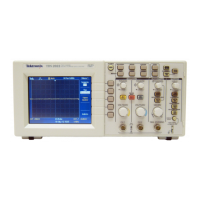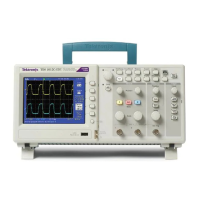Command Syntax
2−4
TDS200/1000/2000 Series Oscilloscope Programmer Manual
Commands
Commands cause the oscilloscope to perform a specific function or
change one of its settings. Commands have the structure:
[:]<Header>[<Space><Argument>[<Comma><Argument>]...]
A command header is made up of one or more mnemonics arranged
in a hierarchical or tree structure. The first mnemonic is the base or
root of the tree and each subsequent mnemonic is a level or branch
off of the previous one. Commands at a higher level in the tree may
affect those at a lower level. The leading colon (:) always returns
you to the base of the command tree.
Queries
Queries cause the oscilloscope to return information about its status
or settings. Queries have the structure:
[:]<Header>?
[:]<Header>?[<Space><Argument>[<Comma><Argument>]...]
You can specify a query command at any level within the command
tree unless otherwise noted. These branch queries return information
about all the mnemonics below the specified branch or level. For
example, MEASUrement:MEAS<x>:UNIts? returns the measurement
units, while MEASUrement:MEAS<x>:TYPe? returns the measurement
type selected for the measurement, and MEASUrement:MEAS<x>?
returns all the measurement parameters for the specified measure-
ment.
Headers in Query Responses
You can control whether the oscilloscope returns headers as part of
the query response. Use the HEADer command to control this feature.
If header is on, the oscilloscope returns command headers as part of
the query and formats the query response as a valid set command.
When header is off, the oscilloscope sends back only the values in
the response. This format can make it easier to parse and extract the
information from the response.
Table 2-3 shows the difference in responses.

